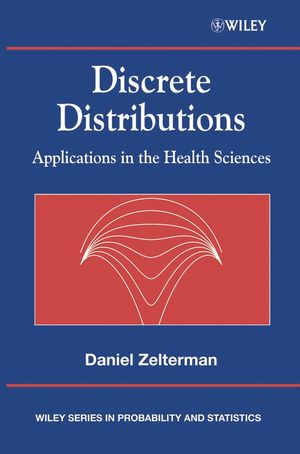Discrete Distributions: Applications in the Health SciencesISBN: 978-0-470-86888-1
Hardcover
312 pages
July 2004
 |
||||||
Acknowledgements.
About the Author.
1 Introduction.
1.1 Discrete Distributions in General.
1.2 Multivariate Discrete Distributions.
1.3 Binomial Distribution.
1.4 The Multinomial Distribution.
1.5 Poisson Distribution.
1.6 Negative Binomial Distribution.
1.7 Hypergeometric Distribution.
1.7.1 Negative hypergeometric distribution.
1.7.2 Extended hypergeometric distribution.
1.8 Stirling’s Approximation.
2 Maximum Negative Binomial Distribution.
2.1 Introduction.
2.1.1 Outfitting the ark.
2.1.2 Medical screening application.
2.2 Elementary Properties.
2.2.1 Shapes of the distribution.
2.2.2 Moments of the distribution.
2.2.3 Modes of the distribution.
2.3 Asymptotic Approximations.
2.3.1 Large values of c and p ≠ 1/2.
2.3.2 Large values of c and p ≠ 1/2.
2.3.3 Extreme values of p.
2.4 Estimation of p.
2.4.1 The likelihood function.
2.4.2 The EM estimate.
2.4.3 A Bayesian estimate of p.
2.5 Programs and Numerical Results.
2.6 Appendix: The Likelihood Kernel.
3 The Maximum Negative Hypergeometric Distribution.
3.1 Introduction.
3.2 The Distribution.
3.3 Properties and Approximations.
3.3.1 Modes of the distribution.
3.3.2 A gamma approximation.
3.3.3 A half-normal approximation.
3.3.4 A normal approximation.
3.4 Estimation.
3.5 Appendix.
3.5.1 The half-normal approximation.
3.5.2 The normal approximate distribution.
4 Univariate Discrete Distributions for Use with Twins.
4.1 Introduction.
4.2 The Univariate Twins Distribution.
4.3 Measures of Association in Twins.
4.4 The Danish Twin Registry.
4.4.1 Estimate of the effect.
4.4.2 Approximations.
4.5 Appendix.
4.5.1 The univariate twins distribution.
4.5.2 Approximating distributions.
4.6 Programs for the Univariate Twins Distribution .
5 Multivariate Distributions for Twins.
5.1 Introduction.
5.2 Conditional Distributions.
5.2.1 Univariate conditional distribution.
5.2.2 Conditional association measure.
5.3 Conditional inference for the Danish twins.
5.4 Simultaneous Multivariate Distributions.
5.5 Multivariate Examination of the Twins.
5.6 Infinitesimal Multivariate Methods.
5.6.1 Models with no dependence.
5.6.2 Models for dependence.
5.6.3 The infinitesimal data.
5.7 Computer Programs.
5.7.1 Conditional distribution and association models in SAS.
5.7.2 Fortran program for multivariate inference.
6 Frequency Models for Family Disease Clusters.
6.1 Introduction.
6.1.1 Examples.
6.1.2 Sampling methods employed.
6.1.3 Incidence and clustering.
6.2 Exact Inference Under Homogeneous Risk.
6.2.1 Enumeration algorithm.
6.2.2 Ascertainment sampling.
6.3 Numerical Examples.
6.3.1 IPF in COPD families.
6.3.2 Childhood cancer syndrome.
6.3.3 Childhood mortality in Brazil.
6.3.4 Household T. cruzi infections.
6.4 Conclusions.
6.5 Appendix: Mathematical Details.
6.5.1 The distribution of family frequencies.
6.5.2 A model for covariates.
6.5.3 Ascertainment sampling.
6.6 Program for Exact Test of Homogeneity.
7 Sums of Dependent Bernoulli’s and Disease Clusters.
7.1 Introduction.
7.2 Conditional Models.
7.2.1 General results for conditional models.
7.2.2 Family history model.
7.2.3 Incremental risk model.
7.2.4 The exchangeable, beta-binomial distribution.
7.2.5 Application to IPF example.
7.3 Exchangeable Models.
7.3.1 Exchangeable family history.
7.3.2 Exchangeable incremental risk model.
7.4 Applications.
7.5 Appendix: Proof of Exchangeable Distribution.
8 Weighted Binomial Distributions and Disease Clusters.
8.1 Weighted Models and Clustering.
8.2 The Altham Distribution.
8.3 Application to Childhood Mortality Data.
8.4 A Log-linear Weighted Distribution.
8.5 Quadratic Weighted Distributions.
8.6 Weighted Distributions in General.
8.7 Family History Log-linear Model.
8.8 Summary Measures and IPF Example.
8.9 SAS Program for Clustered Family Data.
9 Applications to Teratology Experiments.
9.1 Introduction.
9.2 Dominant Lethal Assay.
9.3 Shell Toxicology Experiment.
9.4 Toxicology of 2,4,5 T.
Complements.
References.
Index.



